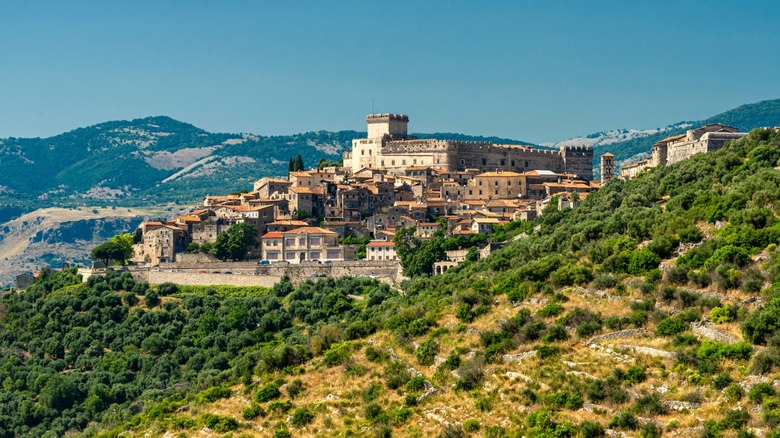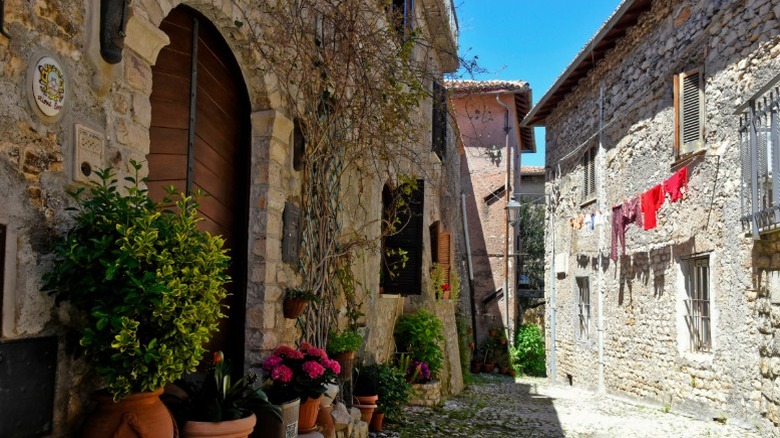
Imagine going from colossal monuments, ancient Roman vigor, and touristic bustle to losing yourself in countryside serenity and Middle Ages antiquity set against rugged mountains in little more than an hour. Sermoneta is only 50 miles from the Eternal City, yet history here flourishes on its own arc, from the prehistoric settlement mentioned in Virgil's Aeneid to one of Italy's most well-preserved medieval villages, picturesquely perched on a hill and suspended in time, overlooking verdant vineyards
and ancient hamlets. Although there are many easy and incredible one-day and weekend trips from Rome, this charming getaway magically whisks you to secret piazzas tucked around warrens of craggy stairs, flower-draped alleys, and arched passageways. It's like walking into the pages of a beloved fable — nothing much has changed since the legendary Knights of Templar roved these cobblestone streets hundreds of years ago, bestowing them with an aura of mysticism.
Once upon a time during Sermoneta's 13th- to 15th-century golden age, the influential Caetani nobles ruled the region from their massive, magnificent castle with watchtowers and battlements soaring into the sky. Fortified by 10-foot-thick walls and a drawbridge network, the mighty citadel survived papal excommunications, Napoleonic attacks, and French and Spanish sieges. Visit the comune's most famous landmark on weekend guided tours that sweep through majestic halls of mirrors and flags, luxuriant chambers opulently frescoed with mythological creatures, and brutal dungeons.
Caetani Castle was also a sanctuary for Knights of Templar escaping persecution elsewhere in Europe, who draped it and the village with their enigmatic legacy that endures in the order's crosses patée insignias inscribed all over town. The Knights' valiant mission to protect Christians on their epic pilgrimage from Canterbury to the Holy Land of Rome is felt poignantly in Sermoneta's popularity as a Via Francigena stop.
Read more: 11 Most Beautiful Universities In Europe
Sermoneta Is One Of Italy's Most Well-Preserved Medieval Villages

Walking is your compass for exploring Sermoneta's pedestrian-only historic heart, so leave your car and modern life behind at one of its four entrances (it's also possible to take a train into the nearby town of Latina from Rome, then take a bus or taxi the 800 feet up the twisty road). It's easy to spend all day meandering lanes of terracotta-topped limestone houses adorned with decorative windows, coats of arms, and carved porticos, bumping into lazing cats lazing while winding your way to atmospheric sights. There's the 13th-century Romanesque Cathedral of Santa Maria Assunta with its exuberant Baroque crucifix, foreboding painting of the seven deadly sins, and looming bell tower; the 12th-century Church of St. Michael the Archangel housing an 18th-century organ; and the elegantly Gothic Loggia dei Mercanti town hall flanked by a distinctive corridor of arches.
Entering the grotto-like gallery of Museo C'era Una Volta to discover a sensational trove of dioramas depicting provincial scenes is an exceptional experience. Each character's actions and facial expressions, along with the items filling their homes and workshops, are intricately handcrafted to historical precision, a vibrant paean to the area's pastoral heritage. A stone buttress encircles Sermoneta, as if to keep time from creeping in but also embracing the village within its storybook setting, a scenic loop for taking a deep panoramic breath of the Lepini mountains reigning over lush Pontine plains. You'll run into the Orange Garden, cue joyful moments clambering up trees plush with citrus and picking as many fruits as you like. On a clear day, gaze all the way to the Tyrrhenian Sea on the horizon, home to Italy's Pontine archipelago, another destination near Rome worthy of a weekend's exploration.
A Charming Weekend Getaway From Rome

This pocket of Lazio serves cucina povera ("poor man's cooking"), reflecting its agrarian bounty, a rural sensibility defined by foraged greens and nose-to-tail butchering. Even polenta, first sown by the Caetanis in 1503, has its own annual festival. Here, a tomato-pecorino ragout or sauce laced with garlic and cured meats is spooned over the porridge, in stark contrast to how this northern staple is sometimes eaten in Venice: as a weird but tasty Venetian street food that combines it with crunchy fried fish. Piazza del Popolo, the social soul of Sermoneta nestled with chatty locals, is perfect for aperitivo with native olives and olive oils, cheeses, wines, and renowned prosciutto from Bassiano, a nearby town. It's an Italian ham that's naturally cured in free-flowing air, infused with fragrances of the Lepini forests for flavors particular to this locale.
Cozy eateries like Trattoria Ghost, cheekily named for a young prince's spirit believed to haunt the castle, serve generations-old comfort food such as bean soup stewed with 18 wild herbs, sheep ricotta with honey and hazelnut, patiently braised wild boar, and handmade durum pappardelle with fennel sausage. Lingering over limoncello and traditional wine cookies, as gregariously insisted by the master of the house, is the Holy Grail of rustic Sermoneta hospitality.
The village after dark is a beguiling fairy tale, dappled by moonlight and warmly glowing streetlamps. Fully submerge into this dreamy timelessness by staying at a family-run inn like Lelive, a gorgeously restored 15th-century house where contemporary furnishings and amenities are right at home within original exposed walls and wood beams. Wake up to a breakfast of homemade cakes, jams from local garden fruit, and all the folklore you have time to savor from your hosts. This is where you, snuggled somewhere between Sermoneta's intriguing history and delectable present, can live happily ever after.
Ready to discover more hidden gems and expert travel tips? Subscribe to our free newsletter for access to the world's best-kept travel secrets.
Read the original article on Islands.













